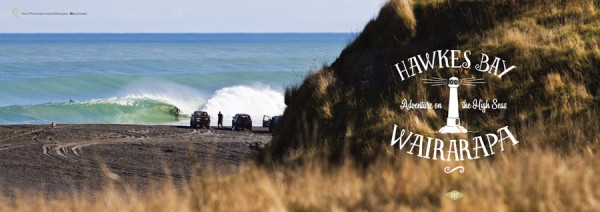The South Seas is a 208-page hardcover photo book of New Zealand surfing co-created by photographer Craig Levers and designer Brent Courtney, published November 2012. In it you’ll find full-page spreads of the North and South Islands’ top-notch breaks firing like they do only on the best of the best days — when the waves get downright magical. The lineup shots and historical photos, the mixed-media artwork, and the written passages offer a compelling look into New Zealand’s surfing past and present.
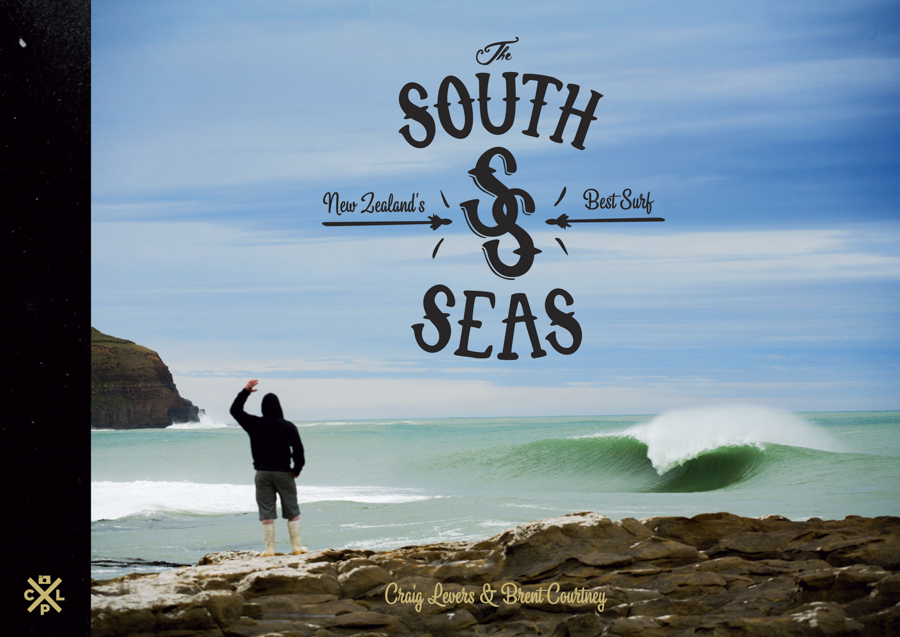

All captions written by co-creator Craig Levers.
Basically bro, this book is sick.
I was lucky enough to exchange a few emails with Craig and learn a little about the process of authoring this rich piece of NZ surf history.
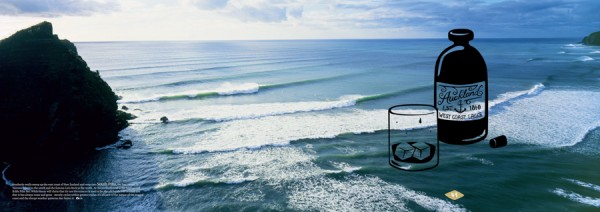
This is my shot and my home beach Piha. It’s shot on a 6x17cm panoramic film camera; I went back to analogue in 2010 because I couldn’t yield the megabytes I wanted in digi. It’s been a huge stoke some of my analogue panoramas made the cut.
ET: How did you get into surf photography? Can you tell me a little bit about your background in the surf media and then becoming a photographer working with specialized gear — and how those experiences equipped you with the skills needed to create a book like South Seas?
CL: I started shooting surf like most surfers do — it was sort of a default thing. By 22 I had already done a fair bit of surf travel through the Pacific, Australia, and Indonesia and I just wanted to record my travels; not for any outlet or magazine — it was a simple response to traveling to cool places and wanting a record of it. But I got the shutterbug big-time, I got super amped on shooting — not so much surf photography — just the whole fascination with capturing light.
I think my personality is such that if something takes, I tend to do it all or nothing; photography is one of these things. So recording trips led to taking courses, and in turn commercial assisting, and then at 26 I started full-time employment at New Zealand Surfing Magazine because the editor had already published some of my images and recommended that I should interview. I stayed at the magazine for fifteen years; I was the Senior Photographer for most of that time, and I ran the magazine as the Editor/Editorial Director for eight of those fifteen years.
Over that time it was my responsibility to oversee a team that produced over 100 issues, including supplements to the core mag. So paper and ink has run through my veins for a very long time now.
Although my job title did say Senior Photographer, and photography is a burning passion, the reality of the job was that 60% of my year was spent in the art room or doing the nuts and bolts of seeing an issue through, from shutter pressed to the bookshelf. There was definitely a long time at the magazine where I regarded my role as an editor/writer that knew how to shoot because more time was spent being an editor than being a photographer.
When I left the magazine’s comfort zone in 2008, while I needed to evolve my craft as a photographer, I also wanted to produce a hardcover book. I did that — it worked pretty well, so I did another book, which in turn made economic sense to do another — The South Seas is now book number four for me.
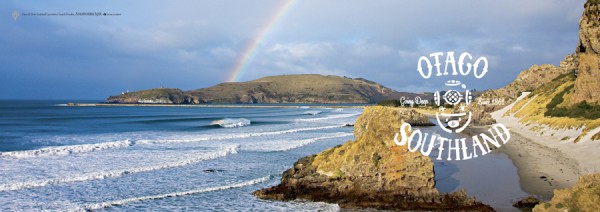
The Aramoana Spit in Otago is a radical fun park of A-frame waves. It’s at the Dunedin’s harbormouth — seals, cold water and big predators. Pic by Silas Hansen.
Who are the major contributors to this photo book — I read there are 16 in all? So is it fair to describe the book as “a major collaboration between surf photographers to document the waves of the entire country” — and is South Seas perhaps unprecedented in its scope?
Silas Hansen and Chris Garden are the two primary contributors. My co-producer Brent Courtney and I knew from day one that if we didn’t have Silas and Gardy onboard the project was dead — we were both prepared to walk away from the concept if either of those two weren’t into it. But they were keen and in fact all the other photogs were stoked and chuffed to be asked. It really felt like quite a uniting project.
Yep you are quite correct, there has never been collaboration on this scale in New Zealand before. Brent and I didn’t want to produce a book that was bound by current commercial publishing house economics. We are both well versed in page cost to profit ratios, but we wanted to take a leap of faith — fuck the accounts department — and produce a book that truly is the best we can make. We got all Wayne’s World on it: ‘If you build it, they will come.’
Did you feel like you were taking on more of a visionary, organizational role as a creator of the book? Can you tell me a bit about the production and editing process? What was the photo selection process like? What photos did you want to have in this book, or not want to have? It seems like this book represents years of photography work — is that true?
Brent took on the role of visionary and foreman; he did the primary photo edit. I acted more in a publisher’s role, but then also wrote the historical chapters and intro — well actually I ended up writing most of the passages, and interviewing key New Zealand surfing pioneers — those chapters kind of mutated into a significant body of work in the end.
Brent’s task as primary photo editor was gnarly. I think he thought I was being a good bugger by opting out of that — but it was brutal, the book is 208 pages plus covers. We had photographic submissions of the highest quality that could have filled another 100 spreads easy. So editing became a nightmare — what one image can succinctly sum up an iconic NZ surf break? The one that makes the local surfers of that break go, ‘yep, fair enough, that’s our wave firing on all cylinders.’ Hehe. Poor Brent.
The photo edit was thrown open to only the best images. We asked the photogs to try not to baffle us with bullshit; to just send us their best — it didn’t matter if it’d been used elsewhere — send us what you truly think are the best shots that represent your region. So there are shots in The South Seas that are over 20 years old in the featured spreads, because they are the best images of that break.
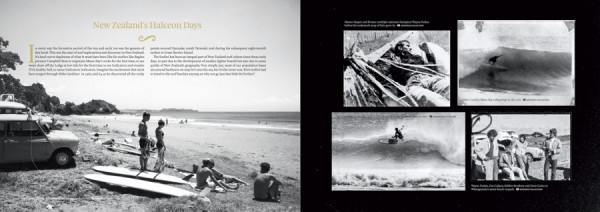
We felt it was important to explain the past and at least explore New Zealand’s rich history of surf culture. How can you know your future if you don’t know where you have been?
Some of the old/historic photos are amazing. How did you get ahold of those?
We had the blessing of the NZ National Library, we sought out all the correct copyrighting and legalities…it was actually pretty amazing how easy and good the staff at the archive and Turnbull Library were to work with. Brent and I really enjoyed collating that stuff; we’d both be firing off screen shots — ‘Look what I found’ — ‘Sick! Dude, check this one out’ — there was some seriously layered web searching going on to cross-reference anything remotely surf related in the National Archive. We had a lot of fun with it.
I guess too, with my time of being involved in NZ surf media, I knew the people that had access to private collections. And one of the wonderful things that has resulted from the book’s publication is all these people are contacting me about historical NZ surfing images. There are a lot of them out there.

Another great image from Silas Hansen — we felt the wintery early morning colours of this shot set the start of the book nicely.
I read this was a long-time idea for you and Brent. What was the turning point for making it actually happen?
Yeah, I think the idea for The South Seas book is nothing new, you are right — when Brent and I were working the art-room at NZ Surf Mag (Brent was the graphic designer of the mag for years), a great lineup shot would slide across the light-box to the ol’ catch cry ‘Maaaan s’one has gotta make a Kiwi lineup book!’ But I think we always felt it would be someone else, like someone who’s somehow more qualified. And we were magazine guys; the idea of book making was alchemy to us at that time.
I guess there comes a realization that, ‘Ohhhh, actually who is more qualified? Ohhhhh well, no one else is having a go — fuck it — I’ll step up to the plate and have a swing.’
That said, it was probably just right time: Brent’s at the height of his powers as a creative designer — he’s got multiple books and magazines under his belt now. I had done three successful book projects, so we felt we had the ability and vision to give it a good crack.
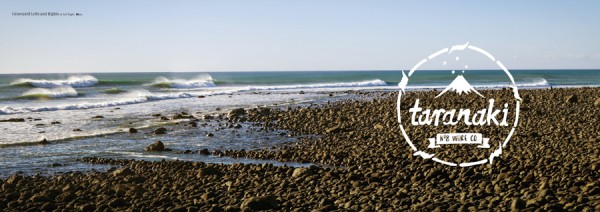
Another of my feature spreads, the opener for the Taranaki region. I actually shot this halfway through production, so while there are shots as old as the early 1900s, there’s images only months old too.
What work have you done so far to promote or sell the book? Can you give the readers a sense of what it’s actually like to be selling/promoting a book after it’s published?
So Brent and I split the roles of the project 50/50 as much as can be done. His role was mainly first half: get the project to print. This was no mean feat; it’s his vision, his art, his hand-drawn graphics, his co-edit. I’m the publisher — I did backseat-drive the edit, but ultimately it’s Brent’s creative work.
My role is the second half: I’m the guy that loaded up the wagon and took it to the shops, packed the orders to the chain stores, dropped it at the warehouses, went on sales runs, which I love. It’s kind of scary presenting something that’s been labored over — that you have emotional investment in — it’s equally a rush when the buyer gives you the thumbs up. We’ve had a lot of thumbs up.
Promo is fun too — I get to contact old journo cohorts and go, ‘Oi, look what we’ve made, gimme some space bro.’ More seriously, we actively and with reasonable result engaged via social media a lot more with this title. It’s been a pretty good test case to compare the direct website sales that have been created through no other way than social media conversations.
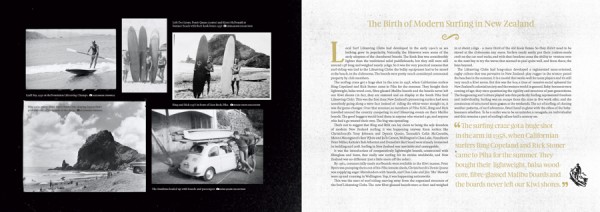
Gathering the archive of historical images was a huge part of the book. While we set out to make a book of Kiwi Lineups, new owners of the book regularly comment it’s the history pages that hook them — that’s a stoke.
As you’re traveling around, are you able to find time to surf?
Surfing? Oh I remember that…Nah I’ve been lucky — New Zealand has just had an exceptional summer for waves, so even though I was under the thumb with the book I’ve snuck in my wave count.
What was your goal of the book? Is it living up to your hopes?
I’ve been asked this question a few times, and I always suspect the interviewer is thinking ‘whatever mate, you know what makes good copy.’ But the hand on chest answer really is: Brent and I just wanted to create a book that was beautiful, that was crafted, that we hoped would make Kiwi surfers go, ‘Yep — this is where I’m from, and it’s a pretty sick place to be a surfer.’
Maybe there’s a reactionary emotion entwined too, in that Brent and I feel the big publishers run book projects to viability studies, not to the creative’s vision. We’ve all seen books that are like, ‘Ohh it’s a small size; Ohhhh, the cover is soft like a magazine; Ohhh, is that really the best photo?’ Big publishing houses crush vision with bottom-line economics. There’s an element of ‘Fuck You,’ do it ‘cos it’s the right thing to do, not ‘cos it’s the prudent thing to do.
We did stuff like a fabric-bound spine, black foil debossed the cover logo, gold debossed the spine, matte UV coated it, ran mixed art stock throughout the 208 pages. Brent’s hand-drawn chapter titles are nowadays virtually an unheard of practice, ‘cos yep, a big publisher would baulk at the hours spent. Then we put a suggested retail price of $80 NZD on it — other books like this retail at $120-200 (I just bought a 180-page book for $150), but we happily knew our market wouldn’t pay that.
I think both Brent and I feel it’s a long way to those ideals for sure.
Check out the book preview.
